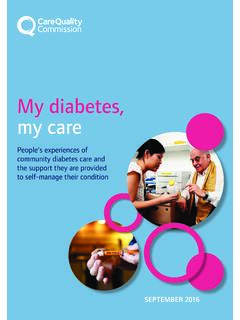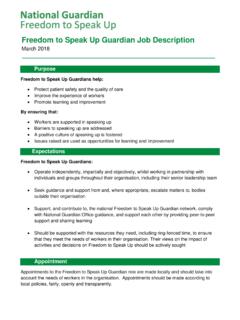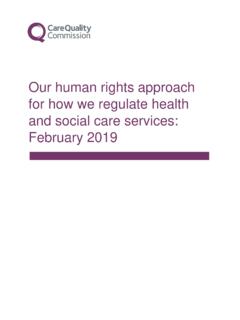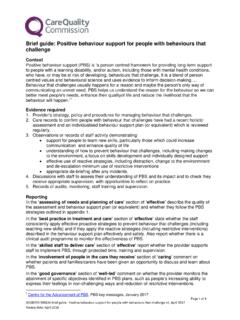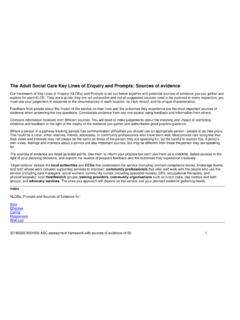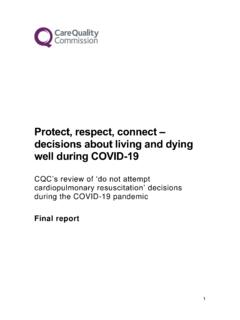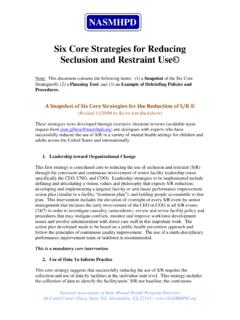Transcription of Out of sight – who cares? - Care Quality Commission
1 OCTOBER 2020A review of restraint, seclusion and segregation for autistic people, and people with a learning disability and/or mental health conditionOut of sight who cares? OUT OF sight WHO cares? About the care Quality Commission Our purposeThe care Quality Commission is the independent regulator of health and adult social care in England. We make sure that health and social care services provide people with safe, effective, compassionate, high- Quality care and we encourage care services to roleWe register health and adult social care monitor and inspect services to see whether they are safe, effective, caring, responsive and well-led, and we publish what we find, including Quality use our legal powers to take action where we identify poor speak independently, publishing regional and national views of the major Quality issues in health and social care .
2 And encouraging improvement by highlighting good valuesExcellence being a high-performing organisationCaring treating everyone with dignity and respectIntegrity doing the right thingTeamwork learning from each other to be the best we canNotes on the reportThe art on the front cover was drawn by Alexis Quinn. Alexis has lived experience of being secluded and segregated. This is her artistic interpretation about how it feels to be in seclusion and warning: In this report there is content and descriptions of people s lives and experiences, which some people may find distressing. Where we found poor care or risks to people s human rights in our review, we took regulatory action against the service; you can see the full list of the action that we took in appendix A.
3 Some of the stories included in this report are illustrative and some are real life examples. Where we have used real life examples, we asked people to give their consent to include them, and we ensured that we changed any identifiable information, such as age, gender, or location, to protect their identities. Complex care what do we mean?Throughout this report we have in places referred to care as being complex . For the purposes of this report, we are defining complex care as care for people with multiple and sometimes interconnected health, communication and social needs. Their care typically requires coordination and input from a range of skilled professionals who may be employed by different REVIEW OF RESTRAINT, seclusion AND SEGREGATION1 SAFE DATA, SAFE CAREOUT OF sight WHO CARES?
4 ContentsRESTRICTIVE PRACTICE IS A HUMAN RIGHTS ISSUE ..2 FOREWORD ..3 INTRODUCTION ..5 Background ..6 Missed opportunities to avoid hospital focus on people with autism ..8A culture of restrictive practice: an equality and human rights issue ..10 PART 1: HOSPITAL-BASED SERVICES ..13 The Quality of care and environment of hospitals ..13 The Quality of, and access, to advocacy ..18 How restraint was used in hospitals ..20A different service type restrictive practices in secure children s homes ..23 Long-term segregation or prolonged seclusion in hospital ..25 Why it is so hard to leave long-term segregation or seclusion .
5 29 PART 2: COMMUNITY-BASED SERVICES ..32 The Quality of care and environment in adult community services ..33 How restrictive practices were used in adult community services ..36 Segregation and seclusion in community services ..39 Children s residential services restrictive practice and the environment ..41 PART 3: COMMISSIONING ..43 Issues with commissioning cost and oversight ..43 CONCLUSION ..46 RECOMMENDATIONS ..47 APPENDICES ..53 REFERENCES ..69 ClAIRE S STORyOUT OF sight WHO cares? 2 Restrictive practice is a human rights issue To understand the issues around restraint, seclusion , and segregation you must hear from the people who have experienced it first-hand.
6 This report tells the story of restrictive practices from their is the story of Alexis, an academic, international athlete, and school teacher. Alexis was restrained and secluded many times before she was able to leave the hospital S STORY I suffered a personal crisis when my brother died, and I was unable to access appropriate care in my local area. With my ability to manage my autistic reaction to trauma deteriorating, I sought help from mental health services. This proved to be my biggest entered hospital for an initial 72 hours intervention. Due to a catastrophic clash between my autism and the environment, I became overloaded and entered a damaging felt cruel like I was set up to fail.
7 I would never, ever be able to tolerate the lighting, the noise, the chaos and the sensory charged box I was kept in. My different and sensitive autistic neurology was at the mercy of those who held the keys. I began to look as they described violent and dangerous because I couldn t control myself. In total, I was restrained 97 times and secluded 17 times. I was forcibly drugged. The drugs took over every aspect of my very being. My body was battered and bruised, and my identity was fractured. They didn t like the autistic part of me. I tried to tell them that autism is all of me, it s who I am.
8 I argued that my autism couldn t be treated. They said I lacked insight. Knowing I couldn t change, and being labelled as treatment resistant , I grew to hate myself and I lost hope. I d never get out. After three and a half years of restrictive practice in 12 different hospitals around the UK, I fled whilst on a Section 3 to Africa. There, I created a routine. I made my days predictable and my home autism-friendly. Nothing in my house aggravated my sensory system. I weaned myself off the drugs, sought private psychology for the trauma I experienced (starting with the death of my brother).
9 After six weeks, I started work as a teacher again. The key to success is creating the right environment and treating psychological differences with dignity and REVIEW OF RESTRAINT, seclusion AND SEGREGATION3 ForewordThis review has shown that for some people who need complex care , the system lets them down. It is often seen as too difficult to get it right they fall through the gaps. a See Background (page 6) for detailsTo be clear, this is a report about the people we saw and the use of restrictive It is not a comprehensive overview of mental health, learning disability or autism care in England.
10 However, the fact that some of the practices we saw were happening at all has implications for the wider health and care system. We found too many examples of undignified and inhumane care , in hospital and care settings where people were seen not as individuals but as a condition or a collection of negative behaviours. The response to this has often been to restrain, seclude or segregate them. We have seen how the very nature of mental health hospitals can be distressing, particularly for people with a learning disability and/or autistic people. This includes the physical ward environment as well as lack of access to psychological support.
